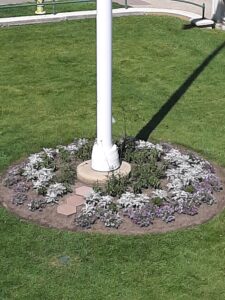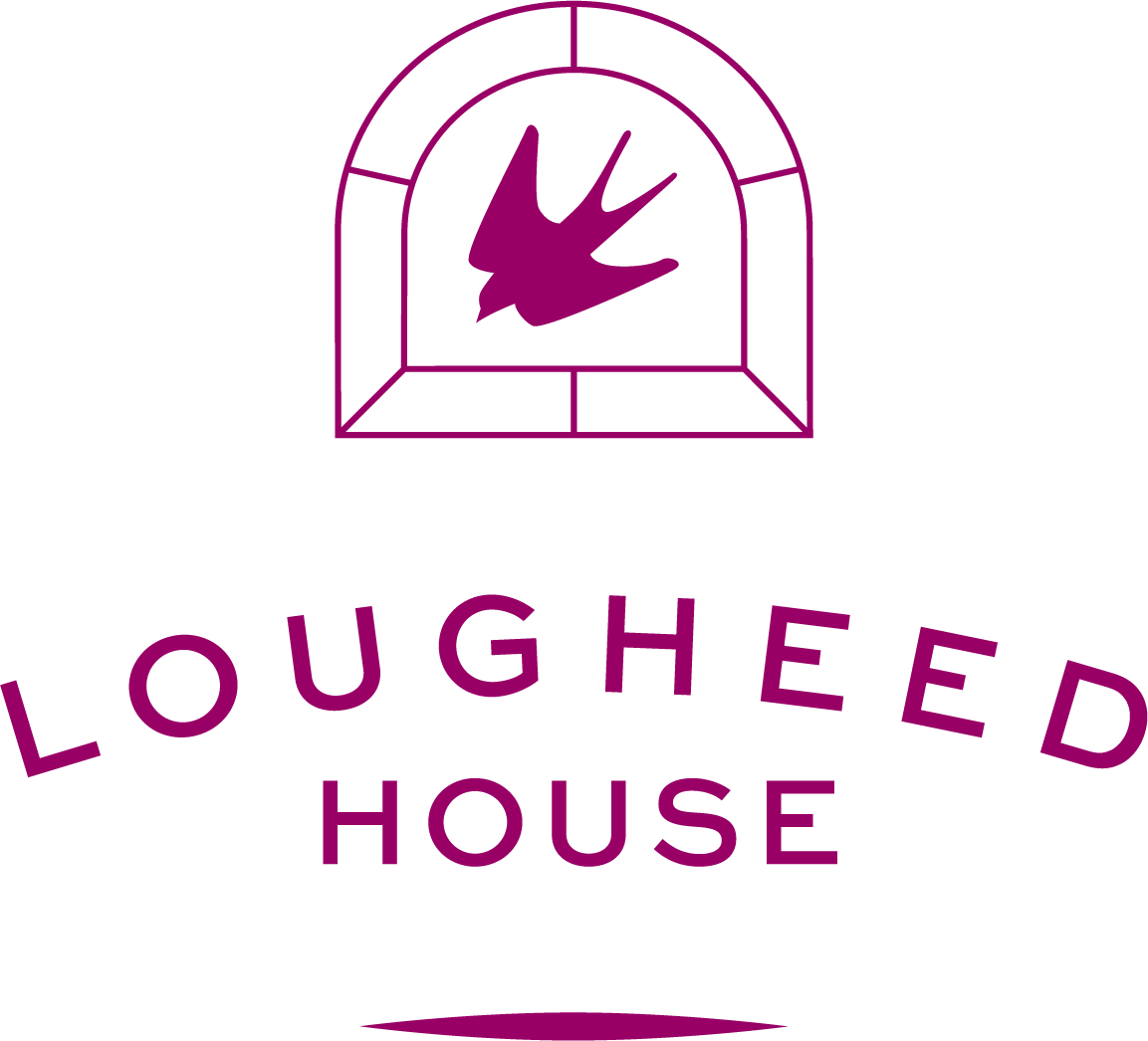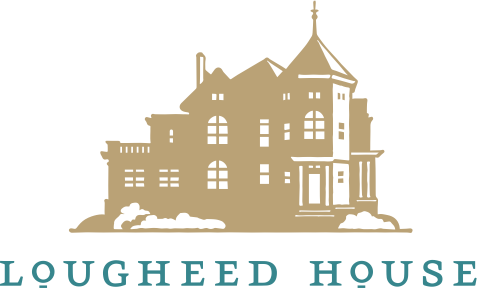Ten questions with Jane Reksten, our new Lougheed House Head Gardener

1. You’ve been Manager of Olds College’s 15 acres of botanic gardens & greenhouses for over 8 years. Tell us about that place.
I was a student at Olds College in the horticulture program from 1996 to 1998 so it was very exciting to go back there in this capacity! The gardens were completed in 2002 and they are now a resource for students and an amazing site for recreation and events. The main gardens consist of 20+ theme gardens and collections like roses and peonies. The wetlands have 19 ponds and walking trails along with a gorgeous perennial garden on a hill with incredible vistas of the entire site. Well worth a trip up the highway.

Jane Reksten with Delphinium
I am on sabbatical for 2020 which is why I am working with Lougheed House this season.
2. You’ve managed many teams of gardeners. What do you find invigorating about working with teams?
I love getting to know the gardeners and what motivates them. To share or instill a love of gardening and to learn from them. I’m always amazed at how much work a happy and productive team can do. I love to see the sense of ownership and connection they create with the garden. You can see the pride in what they have been able to accomplish. I create the big picture, drive the ultimate goals, and steer them in the right direction.
I love seeing the team dynamics come together. I try to facilitate a positive, productive and supportive environment then sit back and watch people and the team dynamics come together.
3. You’ve taught gardening to a lot of people. What is one aspect of gardening that you most like to teach?
Gardening is an inexact science that can’t be practiced by the calendar. And what works in one garden might not work in another garden. So, communicating the underlying science and the ‘why’ of our garden practice is so much more powerful. And of course, it’s always fun to introduce people to new plants!
4. What are some of your personal favourite plants?
Two of my go-to plants are Lady’s Mantle and Bergenia. Both are super reliable and can be used as edging plants, or in small groups. Bergenia has the added advantage of leaves that stay green year-round. For something a bit more unusual I love Itoh Peonies. They don’t need staking and come in colours not usually seen in peonies, like peach, coral and yellow. I also love ornamental grasses – annual or perennial.
5. What will you be doing in/to the Gardens in 2020?
It’s really important not to make any significant changes in a garden without first taking the time to closely to observe and learn about the site, the plants and the people that interact with them. I need to act quickly to inventory and assess the Gardens then synthesize ideas before any changes can be made.
We started with a good spring clean-up and planted annuals, adding new planters to draw attention to the public entrance to the House. Some bed ‘editing’ will be done, then over time we will outline ideas for the design that will help with traffic flow, way-finding and public safety. We want to showcase what is possible in an inner-city garden so interpretation and education will be important goals.
6. Does an inner-city garden have different issues/potential/limitations than one elsewhere?
Inner-city gardens tend to have a more protected microclimate that benefits from the heatsinks found in a city setting. This means opportunities for a different plant pallet and an extended gardening season. As well, it’s always fun to garden for an audience and Lougheed House has an instant one with tourists, local residents and commuters passing through and using the Gardens constantly.
8. Were your parents responsible for your attraction to gardening?
My love of nature drew me to summer jobs like tree planting and work at a fishing lodge. This interest was further influenced by my engineer father’s science focus and my mum’s passion for communication and education in her work as a writer and public speaker. I was drawn to gardening because it brings together science and art, and the history of plants and gardens. Then I found opportunities to relate this passion and information to an audience, and I was hooked.
7. Heritage buildings have special designations and require specialized maintenance and care. What is an “historic garden” and how does its needs differ from any other type of garden?
An historic garden needs to honour and reference the past, while recognizing the changing realities of user groups and stakeholders, climate change and limited resources. Gardens by definition are alive and evolving so we don’t want to be stuck in the past but create an identity that is unique to Lougheed House and its history while still being relevant for the visitors of today.
9. How would you describe the relationship between Lougheed House (the building) and the plants around it?
We want the plantings to be in keeping/context with the House – the connection should be seamless and not jarring in a visual sense. It is also possible to put emphasis on certain parts of the House like the entrance, while taking attention away from other areas like service and storage areas. The plants also connect with the house physically in that vegetables and herbs can make their way into the kitchen and restaurant, and petals collected from the roses are used in products sold in the gift shop.
10. Formal gardens originated as man’s attempt to control nature (in an era when the wildness of nature was seen by many as a threat). Can gardens be about precision and structure, or about nature’s wild energy (or both)?

Flag pole garden planted in purples and silvers for 2020.
There is a strong trend currently to garden styles that emulate nature and create the feeling of wildness without trying to create an exact copy. This doesn’t really mesh with the Victorian aesthetic of formal gardens, bedding plants etc. but it is possible to intermix plants that are native to the prairies and create good habitat for local wildlife, and still create the aesthetic of a well-kept more formal garden space. The integration is what makes this such a great challenge.
11. What are some of your favourite gardening resources?
• Any books by Piet Oudolf – I’ve seen a few of his gardens (Lurie Gardens, The High Line) and find his planting philosophies incredibly inspirational
• Facebook Group – Dutch Dreams global group focused on naturalistic gardening making
• Gardening Magazines – The Gardener for local content; The Garden (monthly member magazine from the Royal Horticultural Society) for international content
• Website – www.itis.gov – best resource for confirming Latin plant names
We respect your privacy as per our Privacy Statement. We welcome your thoughtful and respectful comments, and your first name will appear with each submission. All comments will be moderated by Lougheed House before they appear on the site. We check for posts regularly and will respond as soon as we can. We do not guarantee that your comments will be published.
By submitting a comment, you accept that Lougheed House has the right to reproduce and publish that comment in whole or in part, in any form we choose. We do not endorse the opinions expressed in comments. Comments on this page are moderated according to our Submission Guidelines. Comments are welcome while open. We reserve the right to close comments at any time.



We had the garden tour yesterday (July 8, 2023) and it was really great. Jane shared a lot of information about the house and gardens and their history and evolving development. She is very approachable to ask questions about these or your own garden. Highly recommend.
Loved the garden tour you gave last Thursday. Will you be posting photos and descriptions of all your heritage plants?